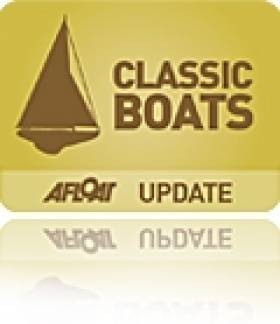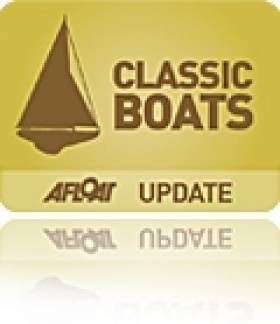Displaying items by tag: Mary Stanford
#RNLI - Ballycotton is in the news again, this time in a feature on RTÉ One's Nationwide next Wednesday 6 August exploring the East Cork town's efforts to bring home their former lifeboat Mary Stanford.
As previously reported on Afloat.ie, the famous lifeboat was saved from being scuttled earlier this year and returned to her spiritual home in Ballycotton in late April.
The Mary Stanford served at Ballycotton for 29 years from 1930 to 1959 and took part in 41 rescues in that time, saving a total of 122 lives.
She was also involved in of the most famous rescues in RNLI history, which took place in February 1936 when she responded to a distress signal from the Daunt Rock Lightship which broke its mooring in a storm.
After a 63-hour mission, the Mary Stanford rescued all eight crew of the lightship and returned to Ballycotton safely. The crew all received RNLI Gold medals.
Unfortunately the Mary Stanford lay rotting in the water at Grand Canal Dock in Dublin after a failed attempt to maintain the boat.
But earlier this year, after local fundraising in Ballycotton, brothers Brendan and Colm Sliney and Colm's son Aidan made the trip to Dublin to bring the vessel back home.
They hired a crane to take the boat from the water and place her on a truck which made the journey to Ballycotton in two stages.
"We just had a few inches to spare going through the Dublin Port tunnel but we got through," recalls Colm Sliney after a heart-in-mouth journey down the motorway to Cork.
In April the team re-grouped to place the Mary Stanford onto a specially built plinth on the cliff walk above Ballycotton, and there were some heart-stopping moments during this mission, too.
The community in Ballycotton now plans to restore the exterior of the lifeboat to her former glory.
The Mary Stanford item will feature on Nationwide on RTÉ One next Wednesday 6 August at 7pm and afterwards on the RTÉ Player.
Legendary Lifeboat 'Mary Stanford' Returns To Spiritual Home
#Lifeboat - The famous lifeboat Mary Stanford, which was saved from being scuttled earlier this year, has returned to her spiritual home in Ballycotton, as the Irish Examiner reports.
Afloat's Jehan Ashmore previously recounted the story of the Barnett-class lifeboat renowned for her role in the daring rescue of crew from the Daunt Rock lightship in 1936.
In recognition of that tremendous effort, the Mary Stanford became the first and only RNLI lifeboat ever to be awarded a hold medal for gallantry.
In more recent years, however, she lay abandoned all but forgotten at Dublin's Grand Canal Dock, next to the similarly neglected Naomh Eanna.
But some did not forget - and the efforts of campaigners have literally put her on a pedestal at the East Cork village's cliff walk, where she was unveiled last weekend.
Work is now getting underway to restore the classic lifeboat to her former glory. The Irish Examiner has more on the story HERE.
Hopes ‘Raised’ for former Lifeboat’s Saving yet Lack of Reprieve Time for Naom Éanna, Campaigners Claim
#HeritageVessels – Following Afloat.ie's weekend coverage of the removal of former RNLB Mary Stanford from Dublin's Grand Canal Dock Basin in Ringend from where she was loaded onto a lorry bound for her original homeport of Ballycotton, further updates will be made in following the progess of her restoration project.
The Barnett-class lifeboat which rescued all 6-crew of the Daunt Rock lightship in 1936 is to relocated to a new plinth overlooking the sea at the East-Cork location. In addition the campaigners of the Mary Standford Project are seeking donations to restore the vessel to her former glory.
During the lifeboat's hoisting operation which involved her removal by the slipway next to the Naom Éanna, the historic heritage ship that once served the Galway-Aran Islands ferry service until she was withdrawn in 1988. She retired to Dublin where she was recently moved from her berth to a nearby graving dock (see photo).
The 1958 built vessel said to be "one of the last riveted ships built in the world" was granted a one-month reprieve to save her from the shipbreakers-torch, following an intervention of the Seanad.
As reported today, campaigners have expressed disappointment at what they claim is too short a stay of execution for the 137ft vessel.
Sam Field Corbett, of the SaveOurShip campaign and marine heritage restoration business Irish Ship & Barge Fabrication, said it had been made clear before last week's debates in Leinster House that 16 weeks would be required to prepare such a plan "involving no State funding".
In the meantime, an online petition has been launched to urge Government to extend the Naomh Éanna's life beyond the present 31 March deadline.
































































